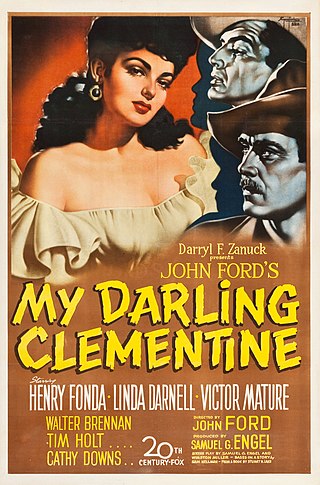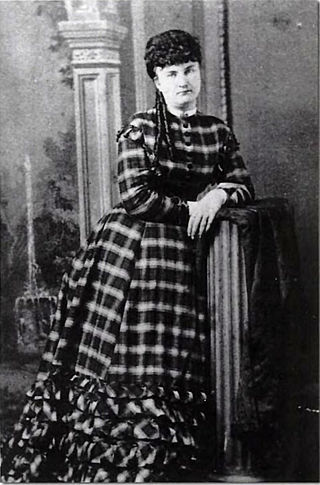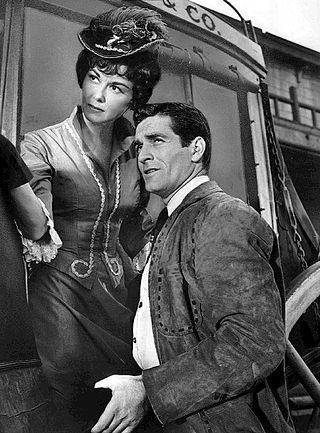
The gunfight at the O.K. Corral pitted lawmen against members of a loosely organized group of cattle rustlers and horse thieves called the Cowboys on October 26, 1881. While lasting less than a minute, the gunfight has been the subject of books and films into the 21st century. Taking place in the town of Tombstone in Arizona Territory, the battle has become one archetype of the American Old West. The gunfight was the result of a long-simmering feud between five outlaws and four representatives of the law, including three brothers. The trigger for the event was the local marshal's decision to enforce a city ordinance that prohibited the carrying of weapons into town. To enforce that ordinance, the lawmen would have to disarm the Cowboys.

My Darling Clementine is a 1946 American Western film directed by John Ford and starring Henry Fonda as Wyatt Earp during the period leading up to the gunfight at the O.K. Corral. The ensemble cast also features Victor Mature, Linda Darnell, Walter Brennan, Tim Holt, Cathy Downs and Ward Bond.

Wyatt Berry Stapp Earp was an American lawman and gambler in the American West, including Dodge City, Deadwood, and Tombstone. Earp was involved in the gunfight at the O.K. Corral, during which lawmen killed three outlaw Cochise County Cowboys. While Wyatt is often depicted as the key figure in the shootout, his brother Virgil was both Deputy U.S. Marshal and Tombstone City Marshal that day and had considerably more experience in law enforcement as a sheriff, constable, and marshal than did Wyatt. Virgil made the decision to enforce a city ordinance prohibiting carrying weapons in town and to disarm the Cowboys. Wyatt was only a temporary assistant marshal to his brother.

Tombstone is a 1993 American Western film directed by George P. Cosmatos, written by Kevin Jarre, and starring Kurt Russell and Val Kilmer, with Sam Elliott, Bill Paxton, Powers Boothe, Michael Biehn, and Dana Delany in supporting roles, as well as narration by Robert Mitchum.

Josephine Sarah "Sadie" Earp was the common-law wife of Wyatt Earp, a famed Old West lawman and gambler. She met Wyatt in 1881 in the frontier boom town of Tombstone in Arizona Territory, when she was living with Johnny Behan, sheriff of Cochise County, Arizona.

John Peters Ringo was an American Old West outlaw loosely associated with the Cochise County Cowboys in frontier boomtown Tombstone, Arizona Territory. He took part in the Mason County War in Texas during which he committed his first murder. He was arrested and charged with murder. He was affiliated with Cochise County Sheriff Johnny Behan, Ike Clanton, and Frank Stilwell during 1881–1882. He got into a confrontation in Tombstone with Doc Holliday and was suspected by Wyatt Earp of having taken part in the attempted murder of Virgil Earp and the ambush and death of Morgan Earp. Ringo was found dead with a bullet wound to his temple which was ruled a suicide. Modern writers have advanced various theories attributing his death to Wyatt Earp, Doc Holliday, Frank Leslie or Michael O'Rourke.

Joseph Isaac Clanton was a member of a loose association of outlaws known as The Cowboys who clashed with lawmen Wyatt, Virgil and Morgan Earp as well as Doc Holliday. On October 26, 1881, Clanton was present at the Gunfight at the O.K. Corral in the boomtown of Tombstone, Arizona Territory but was unarmed and ran from the gunfight, in which his 19-year-old brother Billy was killed.

Wyatt Earp is a 1994 American epic biographical Western drama film directed and produced by Lawrence Kasdan, and co-written by Kasdan and Dan Gordon. The film covers the lawman of the same name's life, from an Iowa farmboy, to a feared marshal, to the feud in Tombstone, Arizona that led to the O.K. Corral gunfight. Starring Kevin Costner in the title role, it features an ensemble supporting cast that includes Gene Hackman, Mark Harmon, Michael Madsen, Bill Pullman, Dennis Quaid, Isabella Rossellini, Tom Sizemore, JoBeth Williams, Mare Winningham and Jim Caviezel in one of his earliest roles.

John Harris Behan was an American law enforcement officer and politician who served as Sheriff of Cochise County in the Arizona Territory, during the gunfight at the O.K. Corral and was known for his opposition to the Earps. Behan was sheriff of Yavapai County from 1871 to 1873. He was married and had two children, but his wife divorced him, accusing him of consorting with prostitutes. He was elected to the Seventh Arizona Legislative Assembly, representing Yavapai County. In 1881, Wyatt Earp served for about five months as undersheriff of the eastern half of Pima County. When Wyatt resigned, Behan was appointed to fill his place, which included the mining boomtown Tombstone. When Cochise County was formed in February 1881, Behan was appointed as its first sheriff. Tombstone became the new county seat and the location of Behan's office. Sadie Marcus was his mistress, possibly as early as 1875 in Tip Top, Arizona, and certainly from 1880 until she found him in bed with another woman and kicked him out in mid-1881.

The Earp Vendetta Ride was a deadly search by a federal posse led by Deputy U.S. Marshal Wyatt Earp for a loose confederation of outlaw "Cowboys" they believed had ambushed his brothers Virgil and Morgan Earp, maiming the former and killing the latter. The two Earp brothers had been attacked in retaliation for the deaths of three Cowboys in the Gunfight at the O.K. Corral on October 26, 1881. From March 20 to April 15, 1882, the federal posse searched southeast Cochise County, Arizona Territory for the men they believed were responsible for the attacks on Virgil and Morgan. Several suspects had been identified and were charged, but were soon released by the court, owing in some cases to legal technicalities and in others to the strength of alibis provided by the Cowboy gang. Wyatt subsequently pursued the suspects with a federal warrant.

Celia Ann "Mattie" Blaylock was a prostitute who became the romantic companion and common-law wife of Old West lawman and gambler Wyatt Earp for about six years. Knowledge of her place in Wyatt's life was concealed by Josephine Earp, his later common-law wife, who worked ceaselessly to protect her and Wyatt's reputation in their later years. Blaylock's relationship with Earp was rediscovered by Earp researcher John Gilchriese and author Frank Waters in the 1950s, when they uncovered a coroner's report for "Mattie Earp", and a deathbed conversation in which she told someone, "Wyatt Earp had ruined my life."

Wyatt Earp: Frontier Marshal (1931) was a best-selling biography of Wyatt Earp written by Stuart N. Lake and published by Houghton Mifflin Company. It was the first biography of Earp, written with his contributions. It established the Gunfight at the O.K. Corral in the public consciousness and conveyed an extraordinary story about Wyatt Earp as a fearless lawman in the American Old West. Earp and his wife Josephine Earp tried to control the account, threatening legal action to persuade Lake to exclude Earp's second wife from the book. When the book was published, neither woman was mentioned.

Doc is a 1971 American Western film, which tells the story of the Gunfight at the O.K. Corral and of one of its protagonists, Doc Holliday. It stars Stacy Keach, Faye Dunaway, and Harris Yulin. It was directed by Frank Perry. It was the first film of his to not be written by Eleanor Perry; Pete Hamill wrote the original screenplay. The film was shot in Almeria in southern Spain.

The 1976 book I Married Wyatt Earp was published as an authentic, personal memoir of his widow Josephine Earp, but after 23 years as a best-selling non-fiction book, was described as a fraud, creative exercise, and a hoax. Originally published by the respected University of Arizona Press, it is the second best-selling book about western Deputy U.S. Marshal Wyatt Earp ever sold. It was regarded for many years as a factual account that shed considerable light on the life of Wyatt Earp and his brothers in Tombstone, Arizona Territory. It was cited in scholarly works, assigned as classroom work, and used as a source by filmmakers. The book's author, amateur Earp historian Glenn Boyer, said that the retouched image on the cover of a scantily-clad woman was of Josephine in her 20s, and based on his statements, copies of the image were later sold at auction for up to $2,875.

Wyatt Earp: Return to Tombstone is a 1994 American Western television film starring Hugh O'Brian as Wyatt Earp, featuring new footage mixed with colorized sequences from O'Brian's 1955–1961 television series The Life and Legend of Wyatt Earp.

Glenn G. Boyer was a controversial author who published three books and a number of articles about Wyatt Earp and related figures in the American Old West. He was the first person to reveal the existence of Wyatt Earp's second wife, Mattie Blaylock. His publications were for many years regarded as the authoritative source on Wyatt Earp's life. However, when other experts began to seek evidence supporting Boyer's work, he would or could not prove the existence of documents that he said he owned and had cited as essential sources. In one case, an individual he cited as a key source was exposed as a complete fabrication. His reputation and the authenticity of his work was seriously damaged. Although he retained many supporters, his work became surrounded by controversy. At least one critic wrote that all of Boyer's later work was "riddled with bogus material".

The O.K. Corral hearing and aftermath was the direct result of the 30-second Gunfight at the O.K. Corral in Tombstone, Arizona Territory, on October 26, 1881. During that confrontation, Deputy U.S. Marshal and Tombstone Town Marshal Virgil Earp, Assistant Town Marshal Morgan Earp, and temporary deputy marshals Wyatt Earp and Doc Holliday shot and killed Billy Clanton, and Tom and Frank McLaury. Billy's brother Ike, who had repeatedly threatened to kill the Earps for some time, had been present at the gunfight but was unarmed and fled. As permitted by territory law, he filed murder charges against the Earps and Doc Holliday on October 30.

Wyatt Earp was an American Old West lawman and gambler in Cochise County, Arizona Territory, and a deputy marshal in Tombstone, Arizona Territory.

The Ten-Percent Ring was a title given by the newspaper editors of The Tombstone Epitaph in 1881 to Johnny Behan and his friends for stealing about ten percent of the local Tombstone, Arizona, taxes in the 1880s. Milt Joyce (1847–1889), owner of the Oriental Saloon and chairman of Cochise County, Arizona, supervisors, was also seen as a leader of the Ten Percent Ring. The Tombstone Epitaph was started by John Clum in 1880.

Wyatt Earp's fame and reputation has varied through the years. While alive, he had many admirers and detractors. Among his peers near the time of his death, Wyatt Earp was respected. His deputy Jimmy Cairns described Earp's work as a police officer in Wichita, Kansas. "Wyatt Earp was a wonderful officer. He was game to the last ditch and apparently afraid of nothing. The cowmen all respected him and seemed to recognize his superiority and authority at such times as he had to use it." He described Wyatt as "...the most dependable man I ever knew; a quiet, unassuming chap who never drank and in all respects a clean young fellow..."


















